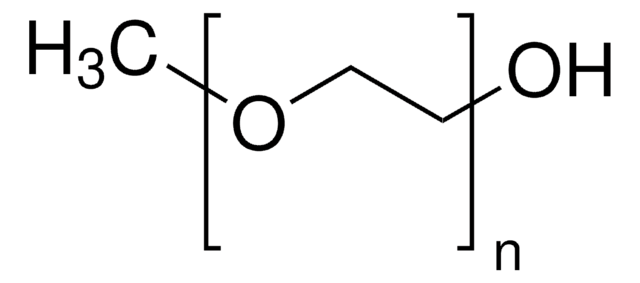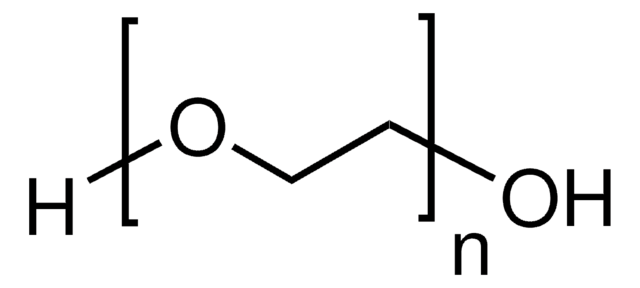732613
Poly(ethylene glycol) methyl ether
average MN 20,000, methoxy, hydroxyl
Synonym(s):
Polyethylene glycol, Methoxy poly(ethylene glycol), Polyethylene glycol monomethyl ether, mPEG
Select a Size
Select a Size
About This Item
Recommended Products
Product Name
Poly(ethylene glycol) methyl ether, average Mn 20,000
vapor density
>1 (vs air)
Quality Level
vapor pressure
0.05 mmHg ( 20 °C)
form
powder or crystals
mol wt
average Mn 20,000
mp
64-69 °C
Mw/Mn
≤1.2
Ω-end
hydroxyl
α-end
methoxy
Looking for similar products? Visit Product Comparison Guide
1 of 4
This Item | D65100 | 270997 | 32222 |
|---|---|---|---|
| Quality Level 100 | Quality Level 100, 200 | Quality Level 200 | Quality Level 200 |
| technique(s) HPLC: suitable | technique(s) - | technique(s) gas chromatography (GC): suitable | technique(s) - |
| assay ≥99.9% | assay ≥99.5% | assay ≥99.8% | assay ≥99.9% (GC) |
| form liquid | form liquid | form liquid | form liquid |
| UV absorption λ: 235 nm Amax: 1.00, λ: 250 nm Amax: 0.05, λ: 340-400 nm Amax: 0.01, λ: 240 nm Amax: 0.20, λ: 260 nm Amax: 0.02 | UV absorption - | UV absorption - | UV absorption - |
| vapor pressure 24.45 psi ( 55 °C), 6.83 psi ( 20 °C) | vapor pressure 24.45 psi ( 55 °C), 6.83 psi ( 20 °C) | vapor pressure 24.45 psi ( 55 °C), 6.83 psi ( 20 °C), 6.86 psi ( 20 °C) | vapor pressure 24.45 psi ( 55 °C), 6.83 psi ( 20 °C) |
Application
- Deoxycholic acid-grafted PEGylated chitosan micelles for the delivery of mitomycin C.: This study develops PEGylated chitosan micelles grafted with deoxycholic acid for effective delivery of mitomycin C, showcasing the potential of PEGylated compounds in pharmaceutical formulations and drug delivery systems (Zhang et al., 2015).
Storage Class Code
11 - Combustible Solids
WGK
WGK 1
Flash Point(F)
359.6 °F
Flash Point(C)
182 °C
Choose from one of the most recent versions:
Already Own This Product?
Find documentation for the products that you have recently purchased in the Document Library.
Articles
Progress in biotechnology fields such as tissue engineering and drug delivery is accompanied by an increasing demand for diverse functional biomaterials. One class of biomaterials that has been the subject of intense research interest is hydrogels, because they closely mimic the natural environment of cells, both chemically and physically and therefore can be used as support to grow cells. This article specifically discusses poly(ethylene glycol) (PEG) hydrogels, which are good for biological applications because they do not generally elicit an immune response. PEGs offer a readily available, easy to modify polymer for widespread use in hydrogel fabrication, including 2D and 3D scaffold for tissue culture. The degradable linkages also enable a variety of applications for release of therapeutic agents.
Designing biomaterial scaffolds mimicking complex living tissue structures is crucial for tissue engineering and regenerative medicine advancements.
Our team of scientists has experience in all areas of research including Life Science, Material Science, Chemical Synthesis, Chromatography, Analytical and many others.
Contact Technical Service


